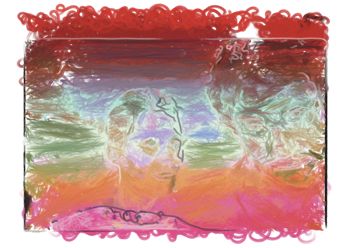A magazine where the digital world meets the real world.
On the web
- Home
- Browse by date
- Browse by topic
- Enter the maze
- Follow our blog
- Follow us on Twitter
- Resources for teachers
- Subscribe
In print
What is cs4fn?
- About us
- Contact us
- Partners
- Privacy and cookies
- Copyright and contributions
- Links to other fun sites
- Complete our questionnaire, give us feedback
Search:
The Painting Fool
by Simon Colton, Goldsmiths College
Can a machine intend to create a work of art? We looked at this during a Paris art exhibition called 'You Can't Know my Mind' with a program called 'The Painting Fool' (www.thepaintingfool.com). We want it to be taken seriously as a creative artist in its own right, one day. At the exhibition, we explored whether people would think of the software as intending to do things.
The Painting Fool painted portraits...but only if it felt like it. When someone sat to have their portrait painted, it was reading the newspaper. If you were unlucky enough to ask for a portrait when it had just read lots of truly miserable articles, it told you to go away, explaining that it didn’t think it was appropriate to paint a portrait when it was in such a (simulated) bad mood. It would send you packing with a miserable quote from a miserable article, and suggest you come back later, when it might be in a better mood. In the context of ‘You Can’t Know my Mind’, we hoped that this would emphasise its independence. In fact, several times, we desperately wanted it to paint a portrait for some VIP, but it refused and we had to live with that decision.
For people who caught the software in a not-so-terrible mood, The Painting Fool would attempt to paint a portrait which captured its mood. If in a good mood – after reading lots of upbeat articles – it asked the sitter to smile. It made clear that it was using them as a model, rather than them using it as a drawing tool. It took a photo for the portrait then made a quick sketch of what it wanted to achieve. It then set about simulating the use of pencils, paints and pastels. It made various choices while painting that it hoped would enhance the chances of people using a particular word like “bright”, “colourful” or “crazy” (if in a good mood) or “dull”, “bleary” or “grey” (if in a bad mood) to describe the portrait.
At the end, The Painting Fool took a long hard look at the portrait, to check whether its picture matched the mood it hoped to portray. Finally it told the sitter how well it thought it had done, and whether this was a “great success”, “miserable failure” or somewhere in-between. It also learned from its successes and its mistakes, so that it became more likely to achieve the required mood with future portraits. We asked people whether they thought the software had exhibited a little intentionality. Now we ask you: what do you think?



